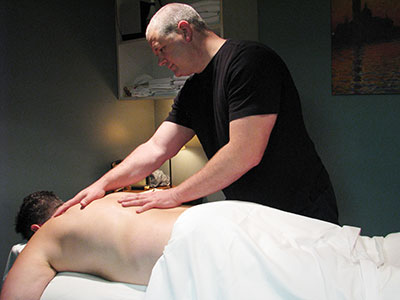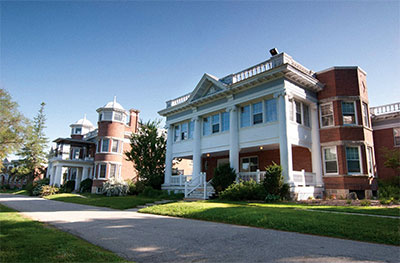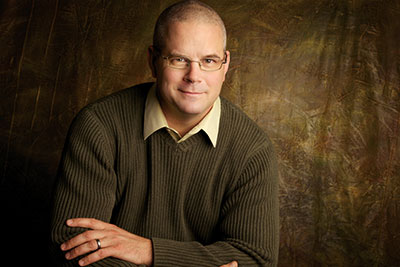
Features
Patient Care
Practice
Touching addiction
September 27, 2013 By Chris O'Connor
In memoriam: Christopher Terrence O’Connor passed away suddenly on March 27, 2018. Massage Therapy Canada was fortunate enough to work with Chris over the years and share in mourning with his friends, family and the rest of the profession.
For the last 14 years I have had a very unique clinic space located inside the Homewood Health Centre in Guelph, Ont. The Homewood Health Centre is one of very few private health-care facilities in Canada specializing in the treatment of addictions, eating disorders, trauma/PTSR (post traumatic stress recovery), chronic pain and psychiatric disorders. RMT services have been provided out of this facility for almost 20 years – the demographic certainly creating an out-of-the-ordinary setting for a massage practice.
 |
|
| Treatment room disclosure by clients is not uncommon. It’s a delicate balance for massage therapists to offer a compassionate ear without overstepping therapeutic boundaries.
|
In this three-part series I would like to share some of my experiences, and just a little of what I have learned treating people from three of Homewood’s programs: addictions, eating disorders and trauma/PTSD.
Addictions
“Addiction should never be treated as a crime. It has to be treated as a health problem.” – Ralph Nader, political activist
Individuals suffering from addiction come from all walks of life – any gender, every culture and all ages. It is an illness that is not limited to the stereotypically portrayed images of street drugs and alcohol abuse. Gambling, prescription medications, compulsive sexual behaviour, work, shopping and exercise addictions are also seeing a steady rise. Dr. Gabor Maté, a pre-eminent figure in the field of addiction counselling, admits his own unusual addiction – to classical music. The diversity of the afflictions reminds us as practitioners to treat the individual with the disease, not the disease itself.
The majority of clients who find themselves at Homewood have never before sought professional treatment. These clients are vulnerable and demand a great deal of compassion and professionalism from their health-care team. Admitting that we all display some form of addictive behaviour is an important first step toward maintaining a non-judgmental composure. It is critical to engender feelings of safety and respect so clients may accept you as part of their healing process. While enduring rigorous treatment protocols, offering your clients a reprieve from the hardest parts of recovery will make you a part of the solution, rather than another part of the problem.
Massage therapists treating clients suffering from addictions should remember to have greater-than-average discipline with treatment room banter. Just as an alcoholic is encouraged to avoid bars and social events where drinking is commonplace, so too must the practitioner take great care not to casually discuss drinking with a client who is struggling with recovery. Best not to wear your favourite golf shirt emblazoned with the Guinness or Sleeman or Molson brands either.
Treatment room disclosure from clients, however, is not uncommon and can create an awkward situation. It is a delicate negotiation to be able to offer a supportive and compassionate ear without overstepping the therapeutic boundaries. Massage therapists are not psychotherapists.
Disclosures regarding illegal activities, violations of the Homewood facility’s rules or potentially abusive situations create ethical and legal dilemmas for a therapist. Threat of violence to another or oneself is an absolute must as far as reporting is concerned – but what is a therapist to do if an addict admits they have smuggled alcohol or street drugs into their addiction program? Being privy to “pillow talk” presents some ethical conundrums. At the risk of becoming the “informer” and jeopardizing your therapeutic relationship, it is important to know when safety measures should be taken and treatment staff informed.
How does a massage therapist negotiate universal precautions when treating a population with addictions that put them at greater risk of HIV and hepatitis C infections? My professional experience tells me the risk of transmission of either of these viral infections while giving a massage treatment is so low that no unusual precautions need be taken. It is very important for the clients in these programs to feel worthy of respect, and not to be judged or feared. If you find yourself worried in any way about working with this population, it would probably be best to refer to another therapist.
Treatment
Not feeling is no replacement for reality.” – Larry Michael Dredla, author
As manual therapists we are in a privileged, and important, position to help those recovering from addiction reconnect with their bodies. After years of neglect, self-medicating (numbing), and commonly co-morbid abusive circumstances, many clients have “lost touch” with their bodies. They may no longer be attuned to how their body is functioning. They may no longer be “feeling” at all. At this time of reconnection with feeling at all levels, positive touch can be immensely important.
No particular techniques are needed, no extra courses are necessary – just a willingness to have the added sensitivity this group requires. In the beginning, I typically focus on full body relaxation treatments to help with the reconnection process, before moving slowly into treatment of specific conditions. This important burgeoning of awareness can also be a good time to seize a teaching moment. By sharing our knowledge of the body and its systems, we can help educate clients and inspire them to take better care of themselves.
Keeping in mind that we are working with individuals who may still have some impulse control challenges, we need to be aware that some will go overboard with the treatment and with advice on homecare that we provide. “The deeper the better,” is often the request regarding pressure during treatment. Because these individuals have been numb to touch for some time, the belief is that they should really be able to “feel” the treatment for it to be effective.
As many of us know, too much pressure can have a negative effect and, in this situation, might leave the client tempted to seek out something more nefarious to help ease the pain.
Weight gain is one of the most common, and frustrating, side-effects of the pharmaceuticals used to treat people recovering from addiction. The side-effects of the meds, coupled with a common tendency to replace one substance with another, i.e., sugar-loaded food for alcohol or drugs, contribute to weight gain and concomitant body image issues. Body image insecurities and shyness create another delicate situation requiring your patience and compassion. We must be mindful of these sensitivities when treating areas where the client may have put on weight, and never assume the client will feel comfortable enough to mention their sensitivities.
A good percentage of my clients fall into this category, and I have found that some will not reveal their insecurity but react when I am working on certain areas of the body – some have actually apologized for their appearance. I always remind clients that this, too, is part of the process of healing but encourage them to talk to their doctor and support team if they feel that overeating has become a new problem.
Knowledge is power
Dr. Maté, a Hungarian-born Canadian physician, author and public speaker, specializes in the study and treatment of addiction. Dr. Maté is widely recognized for his unique and controversial perspective on addiction, attention deficit disorder and chronic disease. He is a firm believer in the connection between mind and body health. His book, In the Realm of Hungry Ghosts, should be the first on your reading list if you choose to work with this unique population. Here is an eye-opening excerpt:
 |
|
| Homewood Health Centre is located in Guelph, Ont.
|
“These…are the traits that most often underline the addiction process: poor self-regulation; lack of basic differentiation; lack of a healthy sense of self; a sense of deficient emptiness; and impaired impulse control…there is no mystery about the circumstances under which the positive qualities of self-regulation, self-worth, differentiation and impulse control fail to develop. Any gardener knows that if a plant hasn’t grown, most likely the conditions were lacking. The same goes for children. The addictive personality is a personality that hasn’t matured. When we come to address healing, a key question will be how to promote maturity in ourselves or in others whose early environment sabotaged healthy emotional growth.”
I strongly support lifelong personal and professional development, for my well-being and the well-being of those I treat. My outlook is useful when fielding difficult questions from some very unhappy and unhealthy clients. As Dr. Maté mentions, although you may be treating adults, certain aspects of personalities may have been arrested at less mature stages. Addicts in recovery are often searching for answers, goals and new directions in life.
Many years ago, I attended a lecture by a doctor who specialized in treating people with addictions. He made an analogy that I remember to this day: “Addicts are like alligators.” At some point during their development, addicts have lost the ability to warm themselves from within, and are always looking for an external source of warmth. He said, “If we take an alligator from Florida, fly them to Winnipeg in the middle of winter and tie them up in the driveway, no amount of counselling, manual treatment, reading or recreation therapy is going to save the alligator from the cold. It needs heat to survive. This is the biggest goal of all therapies: to help those suffering from addiction learn how to warm themselves from within.”
Growth opportunity
The Homewood Health Centre is a haven for those recovering from addiction. Clients are in-patients taking time away from many of their life stressors. Many are anxious about leaving the safety net of doctors, nurses, counsellors and therapists, and will leave the facility in need of ongoing support.
As most RMTs are small business owners, finding new demographics to attract to our business is crucial. Populations in need of evolving care provide an excellent opportunity for a therapist growing their practice to reach out. People with addictions are a demographic often misunderstood and overlooked in our communities. Find a support group and offer your services. Be prepared to show your respect and compassion for the complexity of their challenges.
This is also a great opportunity to put together an outreach program. A colleague of mine, an LMT (licensed massage therapist) in New York City, puts together a free clinic on the second Thursday of each month for those suffering from addiction and post-traumatic stress – many of whom are homeless. The therapists who participate volunteer their time. It is incredibly rewarding work, helps those in need, and is often an eye-opening experience for therapists who attend. It has become so popular with therapists in the community that there are sometimes more practitioners
than clients.
We all know of someone whose life has been affected by addiction; no one is immune to this pathology. With good training, a compassionate demeanour, and a commitment to ongoing personal education and development, manual therapists can be an invaluable part of recovery for each individual encountering addiction. I hope you will feel inspired to reach out to this population, offering them the power and relief that your hands and your knowledge can provide.
A century of care
Homewood Health Centre has been treating patients for addiction since 1883. The programs offered are part of a continuum of care for addicted individuals and family members encompassing: prevention and health promotion; harm reduction; abstinence-based residential; and out-patient treatment and follow-up.
In-patient services are for adults who suffer from chemical addictions including specialized tracks for health care professionals and those suffering from concurrent psychiatric disorders (if psychiatrically stable).
The Homewood Addiction Division Services (HADS) are founded on two underlying principles: abstinence and lifestyle change. Both factors are equally important for successful recovery from addiction.
Program trends and patient characteristics
- 894 patients were discharged from HADS in 2013 – aged 19 to 71, with 63.1 per cent being male.
- Individuals come to HADS on their own volition and the program length is 34 days.
- Individuals seek treatment for addiction/dependency, while some may also have specific psychiatric symptoms. The most common concurrent psychiatric disorders are mood disorders and anxiety disorders.
- 50 per cent of HADS patients have had prior admissions to an in-patient mental health treatment setting at some point in their lifetime.
 |
|
| Figure 1 illustrates that HADS patients displayed positive rates of improvement (greater than 76 per cent) for all outcome indicators.
|
Clinically observed outcomes
The Resident Assessment Instrument-Mental Health (RAI-MH) is a comprehensive, standardized instrument evaluating symptoms and functioning, socio- demographics, behaviours, prior experiences and interventions. The outcomes reflect the percentage of patients whose difficulty with certain symptoms or functioning improved from admission to discharge. (See Figure 1)
Patient short-term outcomes
HADS patients are asked to rate the degree to which they feel they have achieved several short-term outcomes at the time of discharge. The following graph displays the percentages of those who had above average responses for six outcome domains. (See Figure 2 )
 |
|
| Figure 2 illustrates that HADS patients displayed positive rates of achievement (greater than 90 per cent) for all six short-term outcomes.
|
Patient ratings of treatment
Patient ratings of how well treatment met their needs for main addictions, other addictions and psychiatric disorders are considered key indicators of service quality.
- 99 per cent of patients felt treatment met their main addictions needs.
- 90 per cent of patients felt treatment met their other addictions needs.
- 77 per cent of patients felt treatment met their psychiatric disorders needs.
This article was edited by Heather MacRae.
 |
|
Chris O’Connor is a registered massage therapist, public speaker, osteopathic practitioner, provider and instructor of contemporary medical acupuncture. For more information, visit www.chrisoconnorconsulting.com.
Print this page